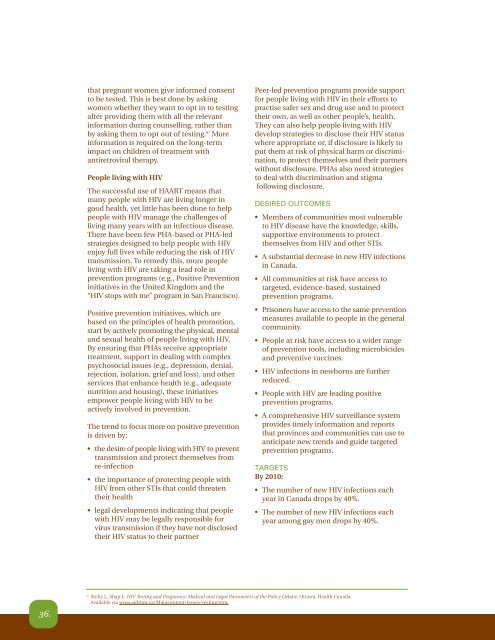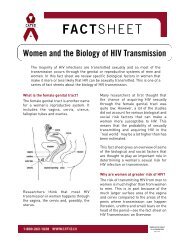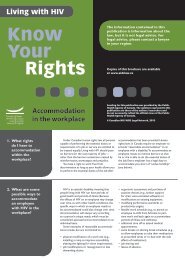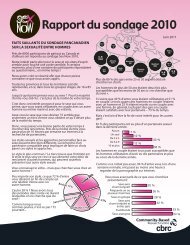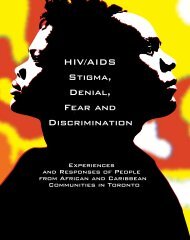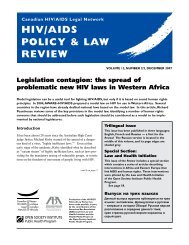leadingtogether: - CATIE
leadingtogether: - CATIE
leadingtogether: - CATIE
- No tags were found...
Create successful ePaper yourself
Turn your PDF publications into a flip-book with our unique Google optimized e-Paper software.
that pregnant women give informed consentto be tested. This is best done by askingwomen whether they want to opt in to testingafter providing them with all the relevantinformation during counselling, rather thanby asking them to opt out of testing. 87 Moreinformation is required on the long-termimpact on children of treatment withantiretroviral therapy.People living with HIVThe successful use of HAART means thatmany people with HIV are living longer ingood health, yet little has been done to helppeople with HIV manage the challenges ofliving many years with an infectious disease.There have been few PHA-based or PHA-ledstrategies designed to help people with HIVenjoy full lives while reducing the risk of HIVtransmission. To remedy this, more peopleliving with HIV are taking a lead role inprevention programs (e.g., Positive Preventioninitiatives in the United Kingdom and the“HIV stops with me” program in San Francisco).Positive prevention initiatives, which arebased on the principles of health promotion,start by actively promoting the physical, mentaland sexual health of people living with HIV.By ensuring that PHAs receive appropriatetreatment, support in dealing with complexpsychosocial issues (e.g., depression, denial,rejection, isolation, grief and loss), and otherservices that enhance health (e.g., adequatenutrition and housing), these initiativesempower people living with HIV to beactively involved in prevention.The trend to focus more on positive preventionis driven by:• the desire of people living with HIV to preventtransmission and protect themselves fromre-infection• the importance of protecting people withHIV from other STIs that could threatentheir health• legal developments indicating that peoplewith HIV may be legally responsible forvirus transmission if they have not disclosedtheir HIV status to their partnerPeer-led prevention programs provide supportfor people living with HIV in their efforts topractise safer sex and drug use and to protecttheir own, as well as other people’s, health.They can also help people living with HIVdevelop strategies to disclose their HIV statuswhere appropriate or, if disclosure is likely toput them at risk of physical harm or discrimination,to protect themselves and their partnerswithout disclosure. PHAs also need strategiesto deal with discrimination and stigmafollowing disclosure.DESIRED OUTCOMES• Members of communities most vulnerableto HIV disease have the knowledge, skills,supportive environments to protectthemselves from HIV and other STIs.• A substantial decrease in new HIV infectionsin Canada.• All communities at risk have access totargeted, evidence-based, sustainedprevention programs.• Prisoners have access to the same preventionmeasures available to people in the generalcommunity.• People at risk have access to a wider rangeof prevention tools, including microbicidesand preventive vaccines.• HIV infections in newborns are furtherreduced.• People with HIV are leading positiveprevention programs.• A comprehensive HIV surveillance systemprovides timely information and reportsthat provinces and communities can use toanticipate new trends and guide targetedprevention programs.TARGETSBy 2010:• The number of new HIV infections eachyear in Canada drops by 40%.• The number of new HIV infections eachyear among gay men drops by 40%.36.87Stoltz L, Shap L. HIV Testing and Pregnancy: Medical and Legal Parameters of the Policy Debate. Ottawa. Health Canada.Available via www.aidslaw.ca/Maincontent/issues/testing.htm.


